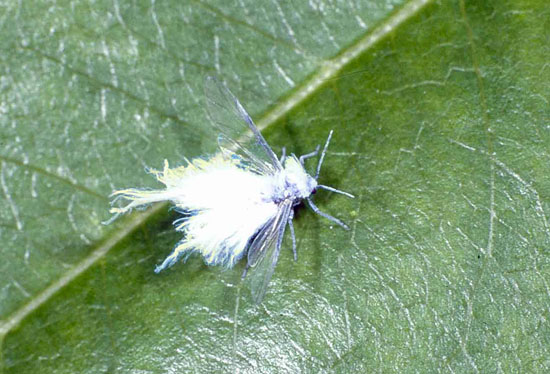Issue 12, July 16, 2012
Woolly Aphids
We've been getting calls about flying lint and tiny drifting angels from throughout the state. These are the winged adults of woolly aphids appearing as a white fuzzy, close to ¼ inch in diameter, which seems to float through the air. If you try to catch one, you soon realize that it is capable of powered flight. These aphids are green to blue and covered with white waxy strands that stand out from the body.

Woolly aphid.
Woolly aphids typically feed on two hosts during a 1-year period, with most species apparently having to switch hosts. This host-switching occurs in various species from late June to late July, and these fuzzy female adults are their means of getting to the other host. Once reaching their summer host, they feed and give birth to additional wingless generations of females, producing winged individuals that fly back to the other host in the fall to lay eggs. These eggs hatch in the spring into females that give birth to more wingless generations of females, producing the winged females that switch hosts at this time of year.
There are several species of these woolly aphids in Illinois. The woolly apple aphid feeds in the spring on apple, pear, hawthorn, and mountainash leaves and then moves to elm leaves for the summer. Woolly elm aphid feeds on elm leaves in spring and then moves to serviceberry, where it feeds on the roots for the summer. Woolly alder aphid feeds on alder and then silver maple. There are also the woolly elm bark aphid, beech blight aphid, Prociphilus tessellatus (ash host), and Prociphilus corrugatans (serviceberry host) that do not apparently switch hosts. We have been seeing more woolly aphids on elm this spring than normal, so these are probably woolly elm aphids.
These insects are more curiosities than pests. Occasionally, a host will experience enough leaf curling and honeydew production to warrant aesthetic control, and woolly elm aphid can damage serviceberry roots. Many insecticides are effective against them while on leaves, including many pyrethroids, imidacloprid, and insecticidal soap. The woolly elm aphid can be controlled on elm leaves to reduce serviceberry root damage later. (Phil Nixon)
Author:
Phil Nixon